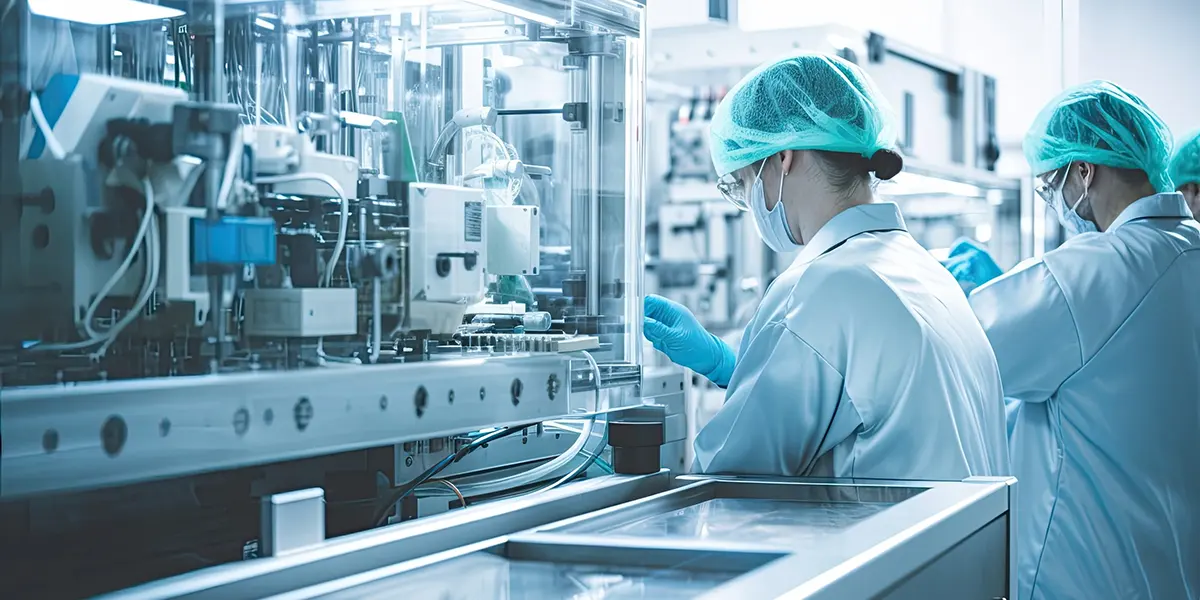The Highly Regulated Process of Medical Device Manufacturing
Medical devices are increasingly important in healthcare. They can diagnose and treat patients more accurately and efficiently than ever before. However, many factors must be considered when designing and manufacturing a medical device. From the materials used to make the device to the type of facility where it is packaged, every step of the process is highly regulated to ensure patient safety. As the MedTech field sees innovations in design and manufacturing, regulations for devices adapt alongside the industry.

MANUFACTURING A MEDICAL DEVICE
The first step in manufacturing a medical device is concept development. Market analysis can identify a need for a new product. Once this need is determined and a concept is developed, design can begin.
Materials in Medical Devices
When designing the product, a strong development team is needed. From choosing materials to programming software, every step requires intentionality. Medical device materials must be considered for biocompatibility, ability to withstand sterilisation and chemical exposure, and regulatory requirements. Repeated sterilisation and cleaning can cause degradation if the wrong materials are used, so choosing suitable materials is crucial for ensuring the safety and longevity of medical devices. Stainless steel, titanium, and cobalt-chromium alloys are all biocompatible metals. Polymers, ceramics, composites, and biomaterials are also commonly used in medical device manufacturing.
Innovations in Software
MedTech devices are becoming increasingly accurate and effective. AI analyses patient data and can assist in pathology, predicting disease progression and potential complications. Devices are also becoming more accessible to the public, with the popularity of wearable fitness trackers that monitor vital signs.
One of the newest classifications of medical devices is Software as a Medical Device (SaMD). SaMD, like AI, can use raw data to glean insights or provide recommendations to patients and care providers. SaMD can be separate from medical device hardware or integrated into an existing device to increase capability. The rise of AI in healthcare and SaMD increases healthcare efficiency and improves clinical outcomes.
Engineers develop software for medical devices. In addition to having a strong technical background, these engineers must also be open to collaborating with healthcare professionals to understand the product’s needs and uses. Due to the added considerations needed when developing a medical device, having a partner with experience in the field is highly valuable.
Product Testing
Building a prototype will help identify any hazards in a medical device’s design. Risk management assessments should follow product safety standards before a product is certified and sent to market. Usability engineering is also vital to mitigating user error by designing and programming user-friendly interfaces.
Once the product is fully developed, it must undergo clinical evaluation. This testing stage, often required in regulatory submissions, evaluates safety and efficacy.
CLEAN ROOMS
Medical devices are manufactured in controlled environments known as clean rooms. In clean rooms, the concentration of airborne particles is controlled and minimised to maintain sterility. The ISO classifies clean rooms by the number of particles per cubic meter.
Air filters reduce particles and maintain air purity, and airflow systems reduce particle buildup. Additionally, the surfaces in clean rooms are carefully selected to avoid materials that are hard to clean or could harbour microorganisms. Clean room staff must also dress in specific attire to minimise outside particles and contaminants.
Consistency is critical in clean rooms. After the proper protocols are established, clean rooms must be regularly cleaned and monitored to ensure that particle levels or climate conditions do not change.
The Importance of a Clean Room in Manufacturing
Clean rooms are used to maintain sterility throughout the manufacturing process. Certain products may go through sterilisation processes in clean rooms. Assembly and packaging of sterile devices also occur in clean rooms to ensure sterility until the point of use. Products commonly manufactured and packaged in clean rooms are implantable devices and diagnostic equipment. Ensuring that a medical device is safe to use is vital to maintaining trust with customers and the manufacturing company’s success.
SAFETY AND PERFORMANCE STANDARDS
To sell a medical device on the global market, it must meet various safety standards. Regulatory laws vary from country to country.
Many products traded in the European market have a CE marking. These markings denote to customers that health and safety requirements have been met and allow businesses to trade the product in the European Economic Area (EEA) without restrictions.
Product Markings in the UK
In 2021, the UK launched a new product marking, the UKCA, to certify medical devices for placement in the Great Britain market. Manufacturers outside the UK must appoint a UK Responsible Person, located in Great Britain, who communicates with the Medicines and Healthcare products Regulatory Agency (MHRA) and provides it with documentation to demonstrate a device’s conformity.
Recognising the rise in AI and SaMD, the MHRA updated the Software and AI as a Medical Device Change Programme in 2023 to ensure that medical device regulations kept up with innovations in the industry.
Although the UK is not part of the EEA, CE markings are still a requirement for devices to be placed on the Northern Ireland market. Great Britain will continue recognising the CE marking until 30 June 2030, provided the devices comply with the EU medical devices directive.
As Great Britain shifts to a new regulatory process for medical devices, it is important to stay current with the latest requirements to get a device to market.
BRINGING YOUR MEDICAL DEVICE TO MARKET
Due to the complexities involved in developing and certifying a medical device, having a partner with expertise and experience in the field is beneficial. It is crucial to have a team that knows how to navigate the certification process, especially as regulatory requirements shift and multiple certifications are required to reach a global market.
Once a medical device is certified by a regulatory agency, it can be sent to market. However, this does not mean that work on the product is done. Post-market surveillance should be conducted to identify any issues with the product or aspects that can be improved upon. Establishing feedback loops with healthcare professionals and patients can provide more significant insights on effectiveness. Monitor for adverse events, which may need to be reported to regulatory authorities. As technology advances and market data is collected, make updates and improvements to the product as needed to remain at the forefront of the field. Stay informed about regulatory best practices to maintain compliance and drive innovation. An ongoing commitment to quality and improvement helps maintain trust and reliability in a medical device.
Pivot UK has over 50 years of experience designing, developing, and bringing MedTech devices to market. In 2021, we were honoured as a Gold Winner at the Medical Design Excellence Awards, the premier awards program in the MedTech industry. We have global teams of engineers that bring a wealth of knowledge in designing products for the medical device field. From optical design to electronics engineering, we are ready to help with your product needs. Contact our team to learn more about how we can help bring your medical device to market.

